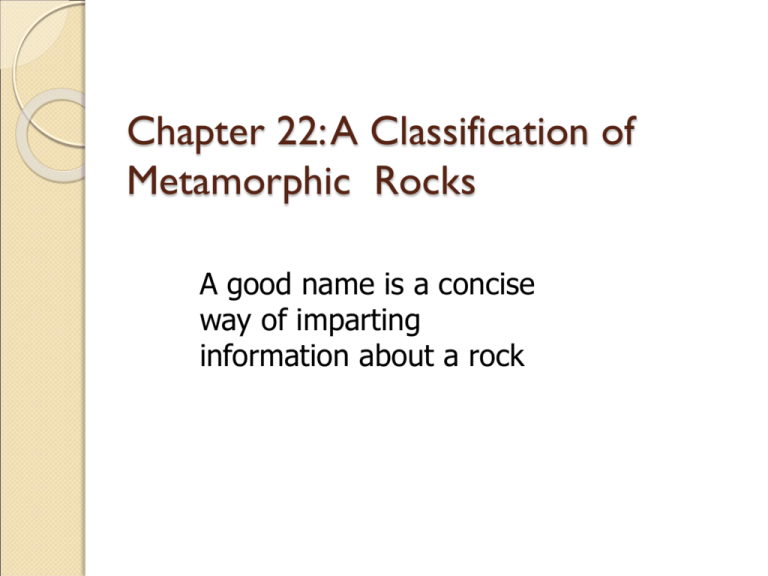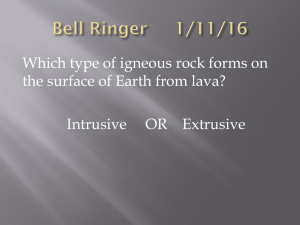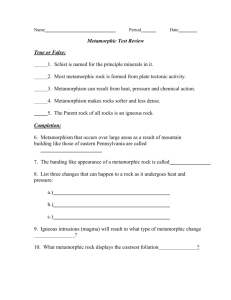Chapter 22: A Classification of Metamorphic Rocks
advertisement

Chapter 22: A Classification of Metamorphic Rocks A good name is a concise way of imparting information about a rock ► Metamorphic rocks are classified on the basis of texture and composition (either mineralogical or chemical) ► Unlike igneous rocks, which have been plagued by a proliferation of local and specific names, metamorphic rock names are surprisingly simple and flexible ► May choose some prefix-type modifiers to attach to names if care to stress some important or unusual textural or mineralogical aspects ►Foliation: any planar fabric element ►Lineation: any linear fabric elements Cleavage • The property of a rock to split along a regular set of sub-parallel, closely-spaced planes • any type of foliation in which platy phyllosilicates are aligned (parallel) but are too fine grained to see without a microscope Schistosity A preferred orientation of mineral grains or grain aggregates produced by metamorphic processes Aligned minerals are coarse grained enough to see with the unaided eye The orientation is generally planar, but linear orientations are not excluded Gneissose AKA gneissic structure Segregated into layers by metamorphic processes Gneissose rocks usually have visible grains b. Phyllite: a rock with a schistosity in which very fine phyllosilicates (sericite and/or chlorite), although rarely coarse enough to see unaided, cause a reflective foliation surface. a. Slate: compact, very finegrained, metamorphic rock with a well-developed cleavage. Freshly cleaved surfaces are dull a b Figure 22-1. Examples of foliated metamorphic rocks. a. Slate. b. Phyllite. Note the difference in reflectance on the foliation surfaces between a and b: phyllite is characterized by a satiny sheen. Winter (2001) An Introduction to Igneous and Metamorphic Petrology. Prentice Hall. Foliated Metamorphic Rocks Schist: metamorphic rocks in which the foliated minerals are coarse enough to see easily in hand specimen. Figure 22-1c. Garnet muscovite schist. Muscovite crystals are visible and silvery, garnets occur as large dark porphyroblasts. Winter (2001) An Introduction to Igneous and Metamorphic Petrology. Prentice Hall. Foliated Metamorphic Rocks Gneiss: a metamorphic rock displaying gneissose structure. Gneisses are typically layered (also called banded), generally with alternating felsic and darker mineral layers. Gneisses may also be lineated, but must also show segregations of felsic-mineral-rich and darkmineral-rich concentrations. Figure 22-1d. Quartzo-feldspathic gneiss with obvious layering. Winter (2001) An Introduction to Igneous and Metamorphic Petrology. Prentice Hall. Non-Foliated Metamorphic Rocks Granofels: a comprehensive term for any rock with no preferred orientation An outdated alternative to granofels is granulite, but this term is now used to denote very high grade rocks (whether foliated or not), and is not endorsed here as a synonym for granofels. Non-Foliated Metamorphic Rocks Marble: a metamorphic rock composed predominantly of calcite or dolomite. The protolith is typically limestone or dolostone. Non-Foliated Metamorphic Rocks Quartzite: a metamorphic rock composed predominantly of quartz. The protolith is typically sandstone. Some confusion may result from the use of this term in sedimentary petrology for a pure quartz sandstone. Metamorphic Rock Facies Greenschist/Greenstone: a low-grade metamorphic rock that typically contains chlorite, actinolite, epidote, and albite. Note that the first three minerals are green, which imparts the color to the rock. Such a rock is called greenschist if foliated, and greenstone if not. The protolith is either a mafic igneous rock or graywacke. Metamorphic Rock Facies Amphibolite: a metamorphic rock dominated by hornblende + plagioclase. Amphibolites may be foliated or non-foliated. The protolith is either a mafic igneous rock or graywacke. Serpentinite: an ultramafic rock metamorphosed at low grade, so that it contains mostly serpentine. Blueschist: a blue glaucophane bearing metamorphosed mafic igneous rock or mafic graywacke. This term is even applied to non-schistose rocks. Eclogite: a green and red metamorphic rock that contains the green clinopyroxene omphacite and pink garnet pyrope. The protolith is typically basaltic. Granulite: a high grade rock of pelitic, mafic, or quartzofeldspathic parentage that is predominantly composed of OH-free minerals. Muscovite is absent and plagioclase and orthopyroxene are common. Skarn: a contact metamorphosed and silica metasomatized carbonate rock containing calc-silicate minerals, such as grossular, epidote, tremolite, vesuvianite, etc. Tactite is a synonym. Migmatite: a composite silicate rock that is heterogeneous on the 1-10 cm scale, commonly having a dark gneissic matrix (melanosome) and lighter felsic portions (leucosome). Migmatites may appear layered, or the leucosomes may occur as pods or form a network of cross-cutting veins. Additional Modifiers Porphyroblastic means that a metamorphic rock has one or more metamorphic minerals that grew much larger than the others. Each individual crystal is a porphyroblast Some porphyroblasts, particularly in low-grade contact metamorphism, occur as ovoid “spots” e.g. spotted hornfels, or spotted phyllite Figure 23-14b. Spotted Phyllite. Winter (2001) An Introduction to Igneous and Metamorphic Petrology. Prentice Hall. Additional Modifying Terms: Some gneisses have large eye-shaped grains (commonly feldspar) that are derived from pre-existing large crystals by shear (as described in Section 23.1). Individual grains of this sort are called auge (German for eye), and the (German) plural is augen. An augen gneiss is a gneiss with augen structure (Fig. 23-18). Additional Modifying Terms: Other modifying terms that we may want to add as a means of emphasizing some aspect of a rock may concern such features as grain-size, color, chemical aspects, (aluminous, calcareous, mafic, felsic, etc.). As a general rule we use these when the aspect is unusual. NOT a calcareous marble or mafic greenschist, as these are redundant, as is a fine grained slate. Additional Modifying Terms: Ortho- a prefix indicating an igneous parent, and Para- a prefix indicating a sedimentary parent The terms are used only when they serve to dissipate doubt. For example, many quartzofeldspathic gneisses could easily be derived from either an impure arkose or a granitoid rock. If some mineralogical, chemical, or field-derived clue permits the distinction, terms such as orthogneiss, paragneiss, or orthoamphibolite may be useful.








